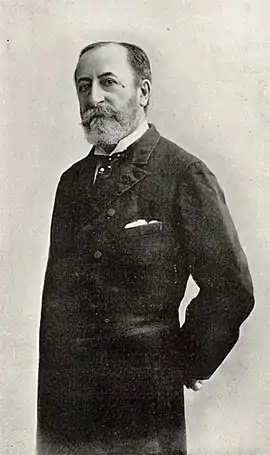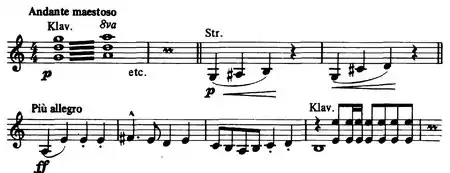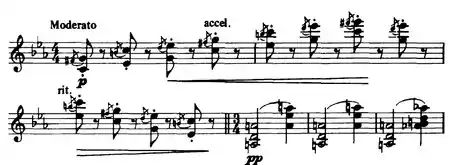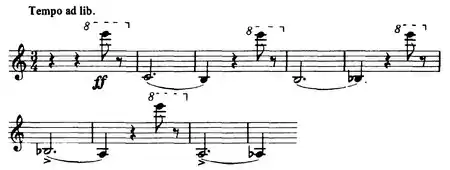The Carnival of the Animals
The Carnival of the Animals (Le carnaval des animaux) is a humorous musical suite of fourteen movements by the French Romantic composer Camille Saint-Saëns. The work was written for private performance by an ad hoc ensemble of two pianos and other instruments, and lasts around 25 minutes.

History
Following a disastrous concert tour of Germany in 1885–86, Saint-Saëns withdrew to a small Austrian village, where he composed The Carnival of the Animals in February 1886.[1] It is scored for two pianos, two violins, viola, cello, double bass, flute (and piccolo), clarinet (C and B♭), glass harmonica, and xylophone.
From the beginning, Saint-Saëns regarded the work as a piece of fun. On 9 February 1886, he wrote to his publishers Durand in Paris that he was composing a work for the coming Shrove Tuesday, and confessing that he knew he should be working on his Third Symphony, but that this work was "such fun" ("... mais c'est si amusant!"). He had apparently intended to write the work for his students at the École Niedermeyer, but it was first performed at a private concert given by the cellist Charles Lebouc on 3 March 1886: "Monsieur Lebouc managed to assemble a definitive line-up of eminent performers: Messieurs Saint-Saëns, Diémer, Taffanel, Turban, Maurin, Prioré, de Bailly and Tourcy who, after a very interesting program, took part in the first performance of a very witty fantasy burlesque, composed for this concert by Saint-Saëns and entitled the Carnival of the Animals. This zoological fantasy was received with great enthusiasm."[2]
A few days later, a second performance was given at Émile Lemoine's chamber music society La Trompette, and another one at the home of Pauline Viardot with an audience including Franz Liszt, a friend of the composer, who had expressed a wish to hear the work. There were other performances, typically for the French mid-Lent festival of Mi-Carême. All those performances were semi-private, except from one at the Société des instruments à vent in April 1892, and "often took place with the musicians wearing masks of the heads of the various animals they represented".[2] Saint-Saëns was adamant that the work would not be published in his lifetime, seeing it as detracting from his "serious" composer image. He relented only for the famous cello solo The Swan, which forms the penultimate movement of the work, and which was published in 1887 in an arrangement by the composer for cello and solo piano (the original uses two pianos).
Saint-Saëns did specify in his will that the work should be published posthumously. Following his death in December 1921, the work was published by Durand in Paris in April 1922 and the first public performance was given on 25 February 1922 by Concerts Colonne (the orchestra of Édouard Colonne).[3]
The Carnival of the Animals has since become one of Saint-Saëns's best-known works, played by the original eleven instruments, or more often with the full string section of an orchestra. Normally a glockenspiel substitutes for the rare glass harmonica. Ever popular with music teachers and young children, it is often recorded in combination with Prokofiev's Peter and the Wolf or Britten's Young Person's Guide to the Orchestra.
Movements
There are fourteen movements, each representing a different animal or animals:
I. Introduction et marche royale du lion (Introduction and Royal March of the Lion)
Strings and two pianos: the introduction begins with the pianos playing a bold tremolo, under which the strings enter with a stately theme. The pianos play a pair of glissandos going in opposite directions to conclude the first part of the movement. The pianos then introduce a march theme that they carry through most of the rest of the introduction. The strings provide the melody, with the pianos occasionally taking low chromatic scales in octaves which suggest the roar of a lion, or high ostinatos. The two groups of instruments switch places, with the pianos playing a higher, softer version of the melody. The movement ends with a fortissimo note from all the instruments used in this movement.

II. Poules et coqs (Hens and Roosters)
Strings without cello and double bass, two pianos, with clarinet: this movement is centered around a pecking theme played in the pianos and strings, which is quite reminiscent of chickens pecking at grain. The clarinet plays a small solo above the strings. The piano plays a very fast theme based on the crowing of a rooster's Cock-a-Doodle-Doo.

III. Hémiones (animaux véloces) (Wild Donkeys Swift Animals)
Two pianos: the animals depicted here are quite obviously running, an image induced by the constant, feverishly fast up-and-down motion of both pianos playing figures in octaves. These are dziggetai, donkeys that come from Tibet and are known for their great speed.

IV. Tortues (Tortoises)
Strings and piano: a satirical movement which opens with a piano playing a pulsing triplet figure in the higher register. The strings play a slow rendition of the famous "Galop infernal" (commonly called the Can-can) from Offenbach's operetta Orphée aux enfers (Orpheus in the Underworld).

V. L'Éléphant (The Elephant)
Double bass and piano: this section is marked Allegro pomposo, the perfect caricature for an elephant. The piano plays a waltz-like triplet figure while the bass hums the melody beneath it. Like "Tortues," this is also a musical joke—the thematic material is taken from the Scherzo from Mendelssohn's incidental music to A Midsummer Night's Dream and Berlioz's "Dance of the Sylphs" from The Damnation of Faust. The two themes were both originally written for high, lighter-toned instruments (flute and various other woodwinds, and violin, accordingly); the joke is that Saint-Saëns moves this to the lowest and heaviest-sounding instrument in the orchestra, the double bass.

VI. Kangourous (Kangaroos)
Two pianos: the main figure here is a pattern of "hopping" chords (made up of triads in various positions) preceded by grace notes in the right hand. When the chords ascend, they quickly get faster and louder, and when the chords descend, they quickly get slower and softer.

VII. Aquarium

Violins, viola, cello (string quartet), two pianos, flute, and glass harmonica. The melody is played by the flute, backed by the strings, and glass harmonica on top of tumultuous, glissando-like runs and arpeggios in pianos. The first piano plays a descending ten-on-one, and eight-on-one ostinato, in the style of the second of Chopin's études, while the second plays a six-on-one. These figures, plus the occasional glissando from the glass harmonica towards the end—often played on celesta or glockenspiel—are evocative of a peaceful, dimly lit aquarium.

VIII. Personnages à longues oreilles (Characters with Long Ears)
Two violins: this is the shortest of all the movements. The violins alternate playing high, loud notes and low, buzzing ones (in the manner of a donkey's braying "hee-haw"). Music critics have speculated that the movement is meant to compare music critics to braying donkeys.[4]

IX. Le Coucou au fond des bois (The Cuckoo in the Depths of the Woods)
Two pianos and clarinet: the pianos play large, soft chords while the clarinet plays a single two-note ostinato; a C and an A♭, mimicking the call of a cuckoo bird. Saint-Saëns states in the original score that the clarinetist should be offstage.

X. Volière (Aviary)
Strings, pianos and flute: the high strings take on a background role, providing a buzz in the background that is reminiscent of the background noise of a jungle. The cellos and basses play a pickup cadence to lead into most of the measures. The flute takes the part of the bird, with a trilling tune that spans much of its range. The pianos provide occasional pings and trills of other birds in the background. The movement ends very quietly after a long ascending chromatic scale from the flute.

XI. Pianistes (Pianists)
Strings and two pianos: this humorous movement (satirizing pianists as animals) is a glimpse of what few audiences ever get to see: the pianists practicing their finger exercises and scales. The scales of C, D♭, D and E♭ are covered. Each one starts with a trill on the first and second note, then proceeds in scales with a few changes in the rhythm. Transitions between keys are accomplished with a blasting chord from all the instruments between scales. In some performances, the later, more difficult, scales are deliberately played increasingly out of time. The original edition has a note by the editors instructing the players to imitate beginners and their awkwardness.[5] After the four scales, the key changes back to C, where the pianos play a moderate speed trill-like pattern in thirds, in the style of Charles-Louis Hanon or Carl Czerny, while the strings play a small part underneath. This movement is unusual in that the last three blasted chords do not resolve the piece, but rather lead into the next movement.

XII. Fossiles (Fossils)

Strings, two pianos, clarinet, and xylophone: here, Saint-Saëns mimics his own composition, the Danse macabre, which makes heavy use of the xylophone to evoke the image of skeletons playing card games, the bones clacking together to the beat. The musical themes from Danse macabre are also quoted; the xylophone and the violin play much of the melody, alternating with the piano and clarinet. Allusions to "Ah! vous dirai-je, Maman" (better known in the English-speaking world as Twinkle Twinkle Little Star), the French nursery rhymes "Au clair de la lune", and "J'ai du bon tabac" (the second piano plays the same melody upside down [inversion]), the popular anthem "Partant pour la Syrie", as well as the aria "Una voce poco fa" from Rossini's The Barber of Seville can also be heard. The musical joke in this movement, according to Leonard Bernstein's narration on his recording of the work with the New York Philharmonic, is that the musical pieces quoted are the fossils of Saint-Saëns's time.

XIII. Le cygne (The Swan)
Two pianos and cello: a slowly moving cello melody (which evokes the swan elegantly gliding over the water) is played over rippling sixteenths in one piano and rolled chords in the other (said to represent the swan's feet, hidden from view beneath the water, propelling it along).
A staple of the cello repertoire, this is one of the most well-known movements of the suite, usually in the version for cello with solo piano which was the only publication of this work in Saint-Saëns's lifetime. More than twenty other arrangements of this movement have also been published, with solo instruments ranging from flute to alto saxophone.
A short ballet solo, The Dying Swan, was choreographed in 1905 by Mikhail Fokine to this movement and performed by Anna Pavlova. Pavlova gave some 4,000 performances of the dance and "swept the world."[6]

XIV. Final (Finale)
Full ensemble: the finale opens on the same trills in the pianos as in the introduction, which are soon reinforced by the wind instruments, the glass harmonica and the xylophone. The strings build the tension with a few low notes, leading to glissandi by the piano before the lively main melody is introduced. The Finale is somewhat reminiscent of an American carnival of the 19th century, with one piano always maintaining a bouncy eighth-note rhythm. Although the melody is relatively simple, the supporting harmonies are ornamented in the style that is typical of Saint-Saëns' compositions for piano; dazzling scales, glissandi and trills. Many of the previous movements are quoted here from the introduction, the lion, the donkeys, hens, and kangaroos. The work ends with a series of six "Hee Haws" from the donkeys, as if to say that the donkey has the last laugh, before the final strong group of C major chords.

Musical allusions
As the title suggests, the work follows a zoological program and progresses from the first movement, Introduction et marche royale du lion, through portraits of elephants and donkeys ("Those with Long Ears") to a finale reprising many of the earlier motifs.
Several of the movements are of humorous intent:
- Poules et coqs uses the theme of Jean-Philippe Rameau's harpsichord piece La poule ("The Hen") from his Suite in G major, but in a quite less elegant mood.
- Pianistes depicts piano students practicing scales.
- Tortues makes good use of the well-known "Galop infernal" from Jacques Offenbach's operetta Orpheus in the Underworld, playing the usually breakneck-speed melody at a slow, drooping pace.
- L'éléphant uses a theme from Hector Berlioz's "Danse des sylphes" (from his work The Damnation of Faust) played in a much lower register than usual as a double bass solo. The piece also quotes the Scherzo from Felix Mendelssohn's A Midsummer Night's Dream. It is heard at the end of the bridge section.
- Fossiles quotes Saint-Saëns' own Danse macabre as well as three nursery rhymes, "J'ai du bon tabac", "Ah! vous dirai-je, Maman" (Twinkle Twinkle Little Star) and "Au clair de la lune", also the song "Partant pour la Syrie" and Rossini's aria, "Una voce poco fa" from The Barber of Seville.
- The Personnages à longues oreilles section is thought to be directed at music critics: they are also supposedly the last animals heard during the finale, braying.
Ogden Nash verses
In 1949, Ogden Nash wrote a set of humorous verses to accompany each movement for a Columbia Masterworks recording of Carnival of the Animals conducted by Andre Kostelanetz. They were recited on the original album by Noël Coward, dubbed over or spliced in between sections of the previously recorded music.[7]
The poems are now often included when the work is performed, though usually recited before each piece. The conclusion of the verse for the "Fossils", for example, fits perfectly with the punchline-like first bar of the music:
- At midnight in the museum hall
- The fossils gathered for a ball
- There were no drums or saxophones,
- But just the clatter of their bones,
- A rolling, rattling, carefree circus
- Of mammoth polkas and mazurkas.
- Pterodactyls and brontosauruses
- Sang ghostly prehistoric choruses.
- Amid the mastodontic wassail
- I caught the eye of one small fossil.
- "Cheer up, sad world," he said, and winked—
- "It's kind of fun to be extinct."
Cultural references
The theme of the prologue of the 1991 soundtrack of the Disney film Beauty and the Beast is intentionally based on the 'Aquarium' movement, as explained by Oscar winner composer Alan Menken in this master class, as a means of promoting French music in a French original fairy tale.
Notable audio/video performances
- In 1976, Warner Brothers broadcast Bugs and Daffy's Carnival of the Animals on CBS, with a full orchestra conducted by Michael Tilson Thomas and featuring Bugs Bunny and Daffy Duck as the duo pianists. This is an abridged version of the work, omitting the "Tortoise", "Characters with Long Ears", "Cuckoo" and "Swan" movements and using the "Pianists" music over the ending credits.
- In 1976, Gary Burghoff acted as host and narrator for a filmed performance released by Twin Tower Enterprises. The performance was filmed at the San Diego Zoo and was performed by the Mormon Youth Symphony Orchestra, and has been released on both VHS and DVD.
- In 1982, The aquarium and finale was used in Impressions de France in the France Pavilion at Epcot, Walt Disney World, Florida, US.
- In 1984, Video Artists International released a taped performance of the original chamber orchestra version of The Carnival of the Animals (VAI 69096), conducted by Paul Lustig Dunkel, using the Ogden Nash verses and featuring Jeremy Irons and Glenn Close as narrators. The performance was taped in commemoration of the 15th anniversary of Hospital Audiences, Inc. before an audience of invited patients from New York City area hospitals and nursing homes and has only been released in VHS format.
- In 1993, an all-star cast recording was released on CD by Dove Audio (ISBN 1-55800-586-2) performed by the Hollywood Chamber Orchestra conducted by Lalo Schifrin with all proceeds going to charity. Readers included (in order of performance): Arte Johnson (Introduction and Finale), Charlton Heston (Royal March of The Lion), James Earl Jones (Hens and Roosters), Betty White (Wild Donkeys), Lynn Redgrave (Tortoises), William Shatner (The Elephant), Joan Rivers (Kangaroos), Ted Danson (Aquarium), Lily Tomlin (Characters with Long Ears), Deborah Raffin (The Cuckoo), Audrey Hepburn (Aviary), Dudley Moore (Pianists), Walter Matthau (Fossils) and Jaclyn Smith (The Swan). Two audio cassette versions were simultaneously released by Dove Audio, one with the above readers (ISBN 1-55800-664-8) and the other under the "Dove Kids" label (Dove Kids 30550) with Fred Savage replacing Arte Johnson. The CD was re-released by Romantic Hours in 2002[8] and is now also available through Audible.com.[9]
- In 1996, a surf rock cover of "Aquarium" was used as the on-ride soundtrack of the original Space Mountain ride layout at Disneyland before its 2005 renovation. It featured guitar riffs by the late Dick Dale.[10]
- In 2000, the finale was set to comical animation of a flamingo playing with a yo-yo to the irritation of his fellow avians in a segment of the Walt Disney Animation Studios animated feature Fantasia 2000.
- In 2016, The Wiggles released The Carnival of the Animals, its narration was written and performed by Simon Pryce. The Album was performed by the Adelaide Symphony Orchestra, and introduced children to classical music and instruments.
- In 2020, A version of The Carnival of the Animals was recorded by British cellist Sheku Kanneh-Mason and his family, with narration performed by actress Olivia Colman and children's novelist Michael Morpurgo.[11][12]
References
- Stegemann, Michael. Camille Saint-Saëns and the French solo concerto from 1850 to 1920. Translator Ann C. Sherwin. Amadeus Press. p. 42. ISBN 0-931340-35-7.
- Blakeman, Edward (2005). Taffanel: Genius of the Flute. Oxford: Oxford University Press. p. 117. ISBN 0-19-517098-9.
- Sabina Teller Ratner (2002). Camille Saint-Saens 1835–1921: A Thematic Catalogue of his Complete Works Volume I: The Instrumental Works. Oxford University Press. p. 185ff. ISBN 978-0-19-816320-6.
- "Carnival of the Animals", The Listener, 18: 104, 14 July 1937, retrieved 30 March 2011
- "Les exécutants devront imiter le jeu d'un débutant et sa gaucherie." "Complete full score" (PDF). Paris: Durand & Cie. Retrieved 20 July 2012.
- Frankenstein, Alfred. "The Carnival of the Animals" (liner notes). Capitol SP 8537 and reissued on Seraphim S-60214. Cite journal requires
|journal=(help) - http://www.discogs.com/André-Kostelanetz-And-His-Orchestra-Noël-Coward-Ogden-Nash-Saint-Saëns-Ravel-Carnival-Of-The-Anim/release/7472182
- "Carnival of The Animals". 23 June 2002 – via Amazon.
- "Audiobooks matching keywords carnival of the animals - Audible.com". www.audible.com.
- "Dick Dale, Guitarist on Space Mountain's Soundtrack, Dies". 18 March 2019. Retrieved 25 December 2020.
- "Olivia Colman is collaborating on her debut classical music album". Harper's BAZAAR. 18 September 2020. Retrieved 1 February 2021.
- Lewis, Susan. "Classical Album of the Week: A Joyous Carnival of the Animals with All 7 Kanneh-Mason Siblings". www.wrti.org. Retrieved 1 February 2021.
External links
- The Carnival of the Animals at IMDb
- Fantasia 2000 at IMDb
- The Carnival of the Animals: Scores at the International Music Score Library Project
- Video Performance of Le Cygne by Julian Lloyd Webber
- Bond discography – Born, featuring the "Aquarium" movement as "Oceanic"
- 2011 recording for organ and piano combined, by David Owen Norris and David Coram
- NY Theatre Ballet Children's Study Guide (PDF), featuring Ogden Nash verses
- Les Deux Love Orchestra's version of L'Aquarium